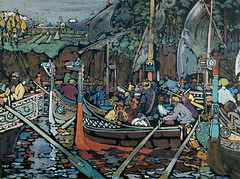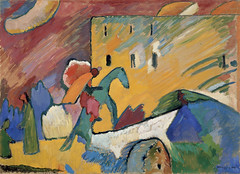Wassily Kandinsky (1866–1944) was a Russian-born painter, wood-engraver, lithographer, teacher, and theorist—a pioneer of abstract art. Born in Moscow, Kandinsky studied law and economics at the University of Moscow, where he lectured after graduation. In 1896, he declined a teaching position and moved to Munich to study art with Anton Azbe, and later at the Kunstakademie with Franz von Stuck. In 1901, Kandinsky founded his first artist group, Phalanx, which opened a school the following year. Kandinsky taught painting and drawing for two years there, and found a long-term companion (until 1916) in student Gabriele Münter. In 1902, Kandinsky exhibited for the first time with the Berlin Secession and produced his first woodcuts. In 1903 and 1904, he began his travels in Italy, the Netherlands, and North Africa and his visits to Russia. He began showing regularly at the Salon d’Automne in Paris beginning in 1904. Russian folk art and fairy tales inspired the artist’s paintings and woodcuts during this time; he was also painting landscape studies directly from nature. In 1908, Kandinsky returned to Munich, where he developed rich, Fauve-like contrasts of color and slowly began to eliminate the representational elements from his paintings, composing instead with increasingly abstract colors and shapes.
In 1909, Kandinsky was elected president of the newly formed New Artists Association of Munich (NKVM), which would have two exhibitions before Kandinsky and Franz Marc left to found the Blue Rider group in 1911. In 1911, Kandinsky published his famous artist treatise Concerning the Spiritual in Art, and in 1912, the first Blue Rider Almanac, which Kandinsky had wanted to produce to stimulate discussion among different genres and artists, was published. Kandinsky had his first one-man exhibition that same year at the Galerie Hans Goltz, Neue Kunst in Munich. In 1913, one of Kandinsky’s works was included in the Armory Show in New York and the First German Autumn Salon at the Der Sturm gallery in Berlin.
From 1914 to 1921, beginning with the outbreak of World War I, Kandinsky resided in Russia, where he was a member of the People’s Commissariat of Education and was appointed to numerous other cultural posts. He returned to Berlin in 1921 and was offered a teaching position at the Bauhaus in Weimar in 1922. At this time, he was highly regarded in Germany as a pioneering abstractionist and theoretician. In 1923, he had his first solo show in New York; the artist never visited the States, but his popularity among collectors, galleries, and museums continued to flourish. He moved with the Bauhaus to Dessau in 1925. There he began to work with precise, geometrical forms and published Point and Line to Plane in 1926. The Nazi government closed the Bauhaus in 1933, and later that year, Kandinsky settled in Neuilly-sur-Seine, near Paris, where he continued to paint. The Nazis confiscated fifty-seven of the artist’s works in the 1937 purge of “degenerate art.” Kandinsky died on December 13, 1944, in Neuilly.
- Arnold Schoenberg – Piano Concerto op. 42 (Impression III (Konzert) was inspired/finished just two days after Kandinsky attended this concert)
- Chopin – Funeral March
- Richard Wagners – Tristan und Isolde
- Alexander Scriabin – Etude Op.8 No.12 Welte-Mignon
- Alexander Scriabin – Prometheus or the Poem of Fire



